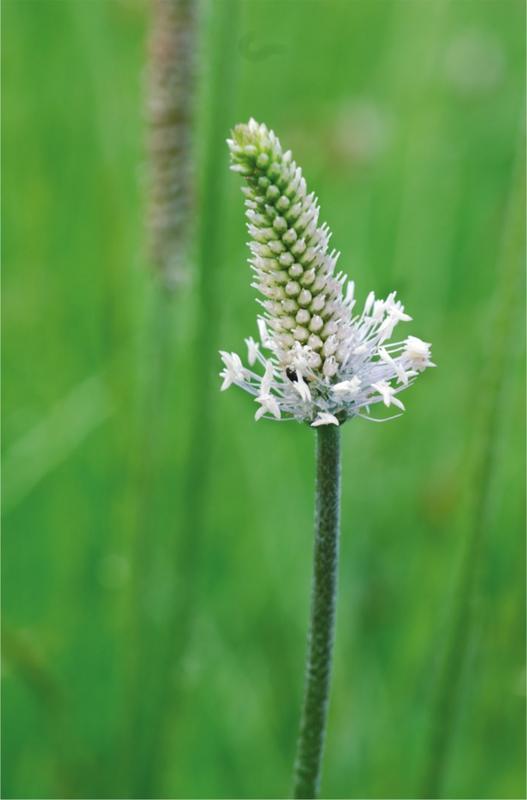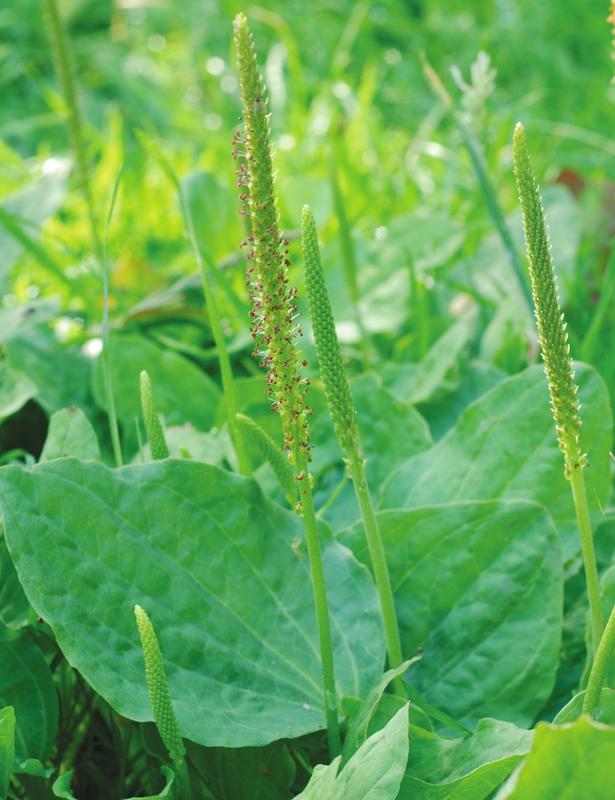Common weeds of footpaths and lawns, the plantains were once celebrated as magical herbs in pre-Christian times, and have followed European settlers around the world.
Plantain is the best first-aid remedy for insect stings, and quickly deals with bites, cuts and ulcers. It is widely available, safe to use and effective for a number of common ailments including old coughs, bronchitis, sore throats and irritable digestive tracts.
Plantaginaceae Plantain family
Description: Perennial plants with a rosette of ribbed leaves and wind-pollinated flowers on erect stalks.
Habitat: Footpaths, roadsides, waste ground, meadows and lawns.
Species used: Greater plantain (P. major), ribwort plantain (P. lanceolata) and hoary plantain (P. media).
Distribution: Ribwort and greater plantain are found virtually throughout the British Isles, while hoary plantain is mainly confined to England. There are around 250 species in the Plantago genus worldwide.
Related species: There are two other British species, which are found mainly around the coast: buckshorn plantain (P. coronopus) and sea plantain (P. maritima). They have similar properties.
Parts used: Leaves, seeds, sometimes root.
Plantain is a plant now regarded primarily as a weed except by herbalists, but it had an illustrious past, being one of nine sacred herbs of the Anglo-Saxons, a ‘mother of worts’. It had a reputation for clearing poisons, from bites as well as infections.
Plantains are found almost anywhere there is human habitation, though they have never had an economic value. Greater plantain in particular grows by preference on the compacted soils of paths and tracks, and seems to thrive on being downtrodden.
To Native Americans this plant became ‘white man’s footprint’, one that sprang up in the footsteps of the settlers. The plant’s name Plantago itself comes from planta or sole of the foot.
The Anglo-Saxon name of plantain was waybroed or waybrode, later ‘waybread’, because it grew by the way or path rather than because it made wonderful eating.
Plantains are familiar ‘weeds’ in any lawn, and will return, even when cut often and short. The young leaves have a slightly bitter flavour from tannins, and though quite tough can be eaten in salads or as a spinach. They become bitter and more fibrous as they age. Buckshorn plantain is grown as a perennial salad crop in Italy and other parts of Europe.
Children all over the world use the flower heads of ribwort, as seen in the photo on the opposite page, as a sort of natural pop gun in the game ‘soldiers’ or ‘kemps’.
In Europe a piece of plantain root used to be carried in the pocket to protect against snakebite, but was no doubt more effective when actually applied to the wound as well as being ingested. The North American name snakeweed is an echo of that time.
Use plantain for…
Ribwort is the number one hedgerow remedy for insect stings and bites. A crushed leaf rubbed onto the painful area will bring relief at once – it’s almost miraculous.

Hoary plantain (Plantago media) is the most beautiful plantain, with pale lilac flowers
Greater plantain also works for pain relief, but the leaves are tougher and not as juicy, so choose ribwort first if it is available. We find that any plantain, applied immediately, is effective for nettle stings and prefer it to dock leaf.
Plantain’s antihistamine effect is also beneficial for hayfever and other allergies, and combines well as a tea with elderflower and mint. Plantain has long been a trusted plant for healing wounds (a vulnerary), and Shakespeare mentions it twice as a healer of broken shins. We haven’t tried it on broken bones, but have found it to be very efficient at clearing heat and inflammation.
A patient of Julie’s had deep red and painful shins from a radiation burn, and came every few days for several weeks for a dressing of fresh plantain juice mixed with slippery elm powder. Other fresh herbs such as chickweed and yarrow were added to the juice at times, but ribwort was the mainstay. The patient’s legs healed and have not needed further treatment.
Julie also uses plantain poultices for the heat and swelling of varicose veins and varicose eczema.
Plantains are great purifiers, with an ability to draw dirt, pus and venom out of wounds. They have even been used to treat blood poisoning and gangrene. A poultice of crushed plantain leaves is the perfect remedy for the skinned knees of childhood, drawing out dirt while soothing and healing.
Abbé Kneipp (1821–97) characterised plantain’s healing action thus:
plantain closes the gaping wound with a seam of gold thread; for, just as gold will not admit of rust, so the plantain will not admit of rotting and gangrenous flesh.
These same qualities make plantain useful for treating infections of the teeth and gums. Simply place a wad of plantain leaf against the affected area and back it up by plantain tea or tincture as a mouthwash. Plantain can be used to help relieve toothache until you can get to the dentist.
Plantain has a soothing effect on the mucous membranes of the digestive tract, and has been used successfully for stomach ulcers and irritable bowel complaints. The leaves stop the bleeding too, so are good for ulcerative colitis. The seeds are even more soothing than the leaf, but probably do not stop the bleeding as well.
The seeds can be eaten raw or cooked, and are very rich in vitamin B1. Ground into a meal and mixed with flour they can make a form of bread. The whole seeds can be boiled like sago, and have a pleasant mild flavour, but this is a bit fiddly and time-consuming.
The seed husks swell up and are very absorbent, providing a source of dietary fibre for constipation and other digestive disorders. It is not surprising that the mucilaginous and binding herb psyllium (or isaphagula) is from Plantago ovata, a close relative of our plantains and native to the Middle East and India. As well as being anti-diarrhoeal the mucilage in plantain is good for starching clothes.
Ribwort is the best of the plantains for treating coughs, and is recommended for chronic bronchitis as well as other persistent irritable coughs. It helps to bring up old stuck phlegm, and is particularly good for hot, dry coughs.
Greater or hoary plantain, having broader leaves, is better for hot, tired feet or plantar fasciitis. Do as the Native Amerticans did and put the leaves in your shoes; keep there until the leaves dry out and then replace by fresh ones.
Plantain’s long history has been benign. One exception came in a case of witchcraft in Scotland. In 1623 Bessie Smith confessed to treating ‘heart fevers’ by giving ‘wayburn leaves’ to take for nine mornings, with a charm. But was this worse than using plantain on St John’s eve, as everyone did?

Plantago major by Maria Merian (1717)

Ribwort leaf with frost crystals outlining the veins
Harvesting plantain
For first-aid use, plantain leaves can be picked and used whenever needed as they remain green through the year. Crush or chew, then apply. If you live in an area with harsh winters, you can freeze the leaves for winter use. For making a medicine to preserve, gather the leaves during the summer. To dry the leaves, spread them on brown paper or a drying screen in a warm dry place, turning the leaves daily until they are crisp. Discard if they go black.
Harvest the seeds when they are ripe, picking the heads and spreading them on brown paper to dry completely before stripping the seeds off for storage in brown paper bags or in jars.
Plantain tea
Use a heaped teaspoonful of crumbled dry leaf or a fresh leaf of plantain per mugful of boiling water, and leave to infuse for ten minutes.
Dose: Drink a mugful three times a day.
Plantain tincture
Pick fresh plantain leaves and put them in a blender with enough vodka to cover them. Blend to a green mush, and pour into a jar. Put in a cool dark place for a few days, then strain and bottle.
Dose: Half to one teaspoonful three times a day.
Plantain succus
Juice fresh plantain leaves and mix the juice with an equal amount of honey. Pour into sterilised bottles and store in a cool place.
Dose: 1 teaspoonful as needed for coughs (ribwort is best); 1 teaspoonful 3 times daily for stomach ulcers. Use externally as a dressing for ulcers and other sores.
Plantain seed
The seeds and husks can be ground in a coffee grinder before use, or used whole.
Dose: 1 teaspoonful sprinkled on food, once to three times daily.

Greater plantain (Plantago major) in flower